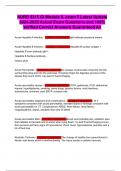NURS 5315 GI Module 9, exam 5 Latest Update
2024-2025 Actual Exam Questions and 100%
Verified Correct Answers Guaranteed A+
Acute Hepatitis A infection - CORRECT ANSWER: IgM antibody presence means
Acute Hepatitis B Infection - CORRECT ANSWER: Hepatitis B surface antigen +
Hepatitis B core antibody IgM +
Hepatitis B Surface Antibody -
means what
Acute Pancreatitis - CORRECT ANSWER: the escape of pancreatic enzymes into the
surrounding area and into the pancreas. Enzymes begin the digestive process of the
tissues they touch which may lead to hemorrhaging.
Acute pancreatitis causes - CORRECT ANSWER: ETOH, gallstones, PUD, abdominal
trauma, hyperlipidemia, smoking, some drugs, genetic factors, viral infections,
autoimmune, ischemia, post ERCP, scorpion bite.
Acute pancreatitis diagnosis and complications - CORRECT ANSWER: 1 of 3:
symptoms consistent with acute pancreatitis, elevated lipase or findings consistent with
acute pancreatitis on CT. Complications: ARDS, heart failure, renal failure,
coagulopathies, sepsis, paralytic ileus and GI bleed
Acute pancreatitis S&S - CORRECT ANSWER: abrupt post prandial pain, epifastric pain
that radiates to the back and is worse when lying down, n/v and if hemorrhaging occurs
then persons will have signs of hypovolemic shock, fever, hypocalcemia, jaundice and a
lot of fluid loss
Alcoholic Cirrhosis - CORRECT ANSWER: The change of healthy liver parenchyma to
fibrotic scar tissue which is nonfunctioning. The injury results in cellular necrosis,
, inflammation and regeneration which leads to fibrosis. The fibrotic changes compress
the blood vessels and develop portal hypertension.
ammonia - CORRECT ANSWER: end product of protein metabolism
Appendicitis - CORRECT ANSWER: Inflammation of the appendix usually in persons
10-19. S&S: periumbilical pain, RLQ pain, nvd, anorexia. Pain may initially be epigastric
or periumbilical then settle in RLQ. Perforation, peritonitis and abscess formation are all
potential complications
Ascites - CORRECT ANSWER: accumulation of fluid in the peritoneal cavity and is a
complication of portal hypertension. Cirrhosis is most common cause. S&S: abdominal
distension, increased abd girth, weight gain and in large volumes dyspnea, increased
respiratory rate, peripheral edema, dilutional hyponatremia and may develop peritonitis.
Autoimmune Hepatitis - CORRECT ANSWER: Autoimmune inflammatory liver disease
that is triggered by infection or drugs. There may be no symtpoms and persons respond
to immunosuppressive drug therapy with remission within 24 hours. Relaspes are
common with treatment withdrawal
Cholecystitis - CORRECT ANSWER: inflammation of the gallbladder from obstruction in
biliary tract. S&S: precipitated by a fatty meal, GERD, positive murphy's sign and
rebound tenderness. Lab abnormalities include leukocytosis, increased alkaline
phosphatase and direct bilirubin.
Cholelithiasis - CORRECT ANSWER: Presence of stones in the gallbladder. Risk
factors include obesity, rapid weight loss, middle age, female gender, oral
contraceptives, native american ancestry, ileal disease, low HDLs, malabsorption
disorders and hypertriglyceridemia.
Chronic Hepatitis A Infection and Marker of Immune status of Hepatitis A - CORRECT
ANSWER: IgG antibody presence means
Chronic Hepatitis B infection - CORRECT ANSWER: Hepatitis B surface antigen +




